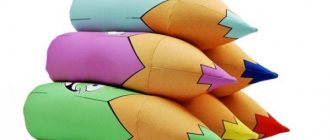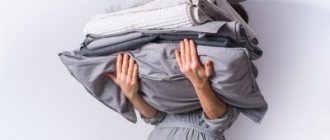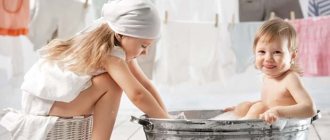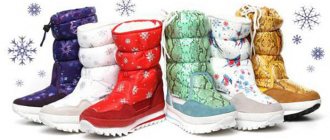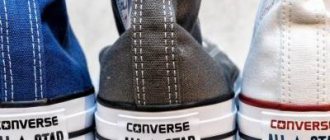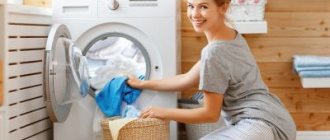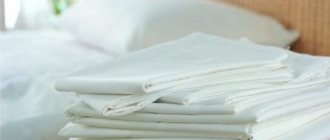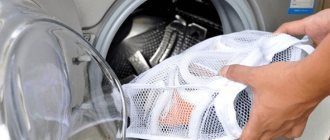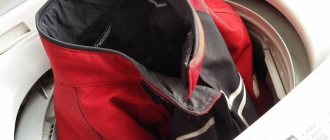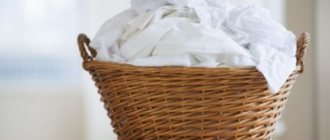The skin of infants is very vulnerable to external factors and therefore requires more careful care. An incorrectly chosen detergent for washing children's clothes often causes the development of redness, peeling, and rashes accompanied by itching. Moreover, the powders contain aggressive volatile particles that easily enter the respiratory tract. Therefore, in order to avoid harmful effects from them, you should carefully choose them and follow several important rules. Let's look further at how to wash a small child's clothes.
Washing rules
The rules for washing children's products are based on the need to ensure the safety of delicate skin and take into account the properties of fabrics. Natural linen and cotton textiles are recommended for bed linen and clothing.
Do I need to wash new clothes?
When purchasing clothes for your baby, as well as bedding sets, you must wash them before using them for the first time. This rule is due to the following circumstances:
- Before reaching the counter, products fall into the hands of different people - weavers, packers, cutters, seamstresses, sellers. This leads to the settling of dust particles and various contaminants, including pathogens, on things.
- During the production process, in order to give it a presentable shape, the fabric is starched. As a result, it becomes tough and can irritate delicate skin.
- Unstable dyes, which are detected during washing because they color the water, often cause allergies in children.
For the first wash, the temperature is set to the maximum possible for a particular type of fabric.
We wash children's clothes
Hand or machine wash clothes?
The answer to this question depends on several factors. A mother, busy caring for her baby and performing many other household duties, does not always manage to find time to do laundry by hand. Then a washing machine comes to the rescue. But sometimes you can’t do without manual care of children’s things. The best option is a combination of hand and machine wash.
In addition, other questions arise before cleaning. For example: “Do I need to wash new things?”, “How to wash diapers?”, “How to wash baby clothes from feces?”
First things first.
- After purchasing clothes for your baby, tear off all tags and tags, having first studied the information on them about caring for things.
- Wash new clothes in a basin with warm water and special children’s “chemistry” without twisting or spinning.
- Rinse the laundry thoroughly (the water should be clear after the last rinse).
- Wring out, straighten and hang the clothes to dry.
- After drying, be sure to iron the baby diapers on both sides and fold them separately from adult clothing.
As for warm and knitted clothes, it is enough to steam them using a steam generator or an iron with a steaming function (without touching the iron to the surface of the laundry).
Before washing, diapers should be rinsed in cool water. This will help remove childhood “surprises” and other stains of biological origin. If there is no time to rinse, fill the laundry with cold water and leave it until it appears.
After rinsing, rub the stains on the clothes on both sides and leave them in a basin without water until washing, which we do not recommend delaying.
If there are only a few dirty items, wash them by hand. Urine and feces are washed well in cool water (15–18 °C). In a basin of water, thoroughly knead the diapers that have been previously rubbed with soap and scrub off any dirt. After rinsing, if stains remain, the procedure can be repeated. Rinse the washed items thoroughly, first in hot water, in which soap particles dissolve, and then in cold water, which washes them off the fabric.
Important! Using a washing machine also requires compliance with the rules.
- First, wash children's clothing separately from adults.
- Secondly, in addition to special washing powder or gel, do not fill in/fill in any other products, such as Calgon.
- Third, choose a double rinse or repeat rinse cleaning program.
It is better to dry things outside, but if your area is polluted with gas, place them on a drying rack in your apartment, not far from heating appliances.
How often to wash
Children's clothing must be washed as soon as traces of contamination are noticed. At the age of up to one year, the procedure is usually carried out daily after an evening bath. This allows you to always have a supply of clean onesies, diapers, and undershirts.
For babies older than one year, if there is a lack of free time, put clothes in a separate basket and wash them twice a week. There are no general recommendations; each mother sets a convenient regime for herself. It is important that your child wears fresh underwear after each bath.
It is recommended to wash bed linen once a week. Emergency washing is required if traces of spilled milk, juice or other dirt appear on the pillowcase or sheet.
Is it possible to wash with adult clothes?
You should immediately create a separate basket for your baby’s things. They should not be near bedding and clothing of adult family members.
For hand washing, purchase a separate basin. It can only be used for this purpose and rinsed regularly with hot water. If you plan to machine wash diapers and other bedding, then they are sorted. And then they put children's colored or white clothes into the drum, washing them separately.
ARTICLE FOR YOU
How to wash Pavloposad scarves: wool and silk in a washing machine and by hand
How to soften fabric?
Newborn baby clothes should not be washed with conditioner to soften them. The following recommendations will help improve the condition of the material and make it softer:
use gel rather than powder to care for your baby’s clothes;- Do not spin the washing machine at high speeds;
- ironing clothes makes the materials softer;
- Do not overdry the products;
- On the washing machine, you can select the additional “no-crease” setting, if such a function is provided.
In addition, worn-out items can become stiff. And also poorly rinsed or poorly washed, on which dirt remains.
Fabric softener should only be used on clothes of older children, not newborns. Treatment with a steam generator will help soften children's clothes.
Wash by hand
One of the features of hand washing children's clothes is the need to maintain a fairly high water temperature, which allows for high-quality cleaning of textiles.
Washing items by hand
To solve this problem, it is recommended to protect your hands. First put on thin cotton gloves and rubber gloves on top. The procedure is carried out in the following sequence:
- Pour hot (65-85˚C) water into an enamel basin - 5 liters.
- Dissolve grated laundry soap or powder - 1 tbsp. l.
- Dried stains are moistened, soaped and lightly scrubbed.
- Immerse the products in a soap solution for a quarter of an hour (if the contamination is significant, the time is increased).
- Wash by hand, scrubbing off any existing stains especially carefully.
Rinse three times, starting with warm and ending with cold water.
When can you start using regular powder?
It is advisable to wash all of your baby’s clothes with a special baby detergent for at least 6 months. If the child has not experienced skin reactions during this period, you can gradually switch to regular powder containing bioregulators, activators and neutralizers for hard water.
To check your baby’s skin reaction to a new product, soak one baby item in the “adult” powder, rinse thoroughly and dry. If the baby has no visible reactions while wearing these clothes, then the powder is suitable.
Washing in a washing machine
When practicing more effective machine washing for a variety of children's products, follow the following rules:
- It is advisable not to wash work clothes, heavily soiled clothes, rugs, rugs, or shoes in the machine you are using.
- Only one children's clothes are placed in the drum, having been pre-sorted by color.
- They install a special program aimed at children's things. In its absence, choose the delicate mode.
- The minimum temperature for linen and cotton dyed in soft pastel colors is about 65˚C. For white natural fabrics, maximum heating up to 90˚C is preferable. To prevent bed linen with rich colors from fading, wash with water no hotter than 40˚C. For such varieties, pre-soaking is not used.
- It is advisable to use the re-rinse function.
How to wash children's clothes in a machine
Air conditioner and various aromatic additives are not used.
Machine washable
The “Children's Wash” function not only gently washes and rinses things, but also preserves the original softness of the fabric, washes at high temperatures and in a large amount of water. In this case, allergenic detergents are completely removed from the fabric fibers. Some new models of washing machines have a disinfection function, in particular using silver nanoparticles that kill bacteria.
Diapers and baby clothes soiled with feces or any products must first be cleaned and then washed at a temperature of 80–90 degrees with double rinsing, or use the “baby wash” function.
Our grandmothers and mothers used to boil diapers and baby clothes. Now there is no such need, since automatic machines can wash at high temperatures. And yet, it very often happens that neither the baby powder nor the machine are able to cope with the stains with which your baby managed to decorate his clothes.
Detergents
The selection of detergents for washing a child’s clothes should be approached responsibly. This is due to the susceptibility of the delicate skin of babies to allergic manifestations.
A suitable powder meets the following requirements:
- inclusion of only natural ingredients that have a gentle effect on the skin;
- complete leaching from the fibers during the rinsing process, which avoids particles of detergent getting into the baby’s respiratory tract and skin;
- give preference to hypoallergenic powders with a corresponding mark on the packaging;
- rapid dissolution without sediment even at low temperatures.
ARTICLE FOR YOU
How to wash a tie correctly: in the washing machine and by hand
Until the age of six months, it is recommended to use soap that is ground into fine shavings.
List of popular brands for gentle washing of children's items that require careful attention:
- gel Domal, “Stork”;
- Powder "Eared Nanny", Dally Med;
- line of detergents “Our Mother”.
The best products for washing children's clothes
When starting to use a new product, carefully monitor the condition of the baby's skin. Symptoms of allergies include red spots, rashes, and itching. You should immediately abandon the brand to which you are intolerant and return to an already proven composition or choose a higher quality powder.
Old stains
With the introduction of the first complementary foods, additional troubles arise with washing clothes. On the one hand, homogenized food is very convenient, because you don’t need to cook anything special, but on the other hand, you have to wash things much more often. You can get rid of severe dirt that has become embedded in a child’s clothes using traditional methods that are highly effective.
Important! Every parent should remember that it is forbidden to use aggressive substances and, in particular, chlorine! Products containing the designated component lead to acute allergic reactions in the baby, and the smell that clothes acquire after washing is almost impossible to remove. In addition, it is not recommended to use baking soda that remains on the fabric.
The best way to remove stains is regular peroxide. The advantages of this tool include:
- safety for the skin of a newborn;
- quick rinsing from fabric;
- effectiveness in removing even old stains;
- disinfecting effect.
At what degrees it is necessary to wash an item treated with peroxide depends on the fabric. However, most often experts recommend setting the temperature to 60 degrees. You should not raise the temperature, otherwise the laundry may acquire a grayish tint.
Mom’s forgetfulness is excusable, because the mass of worries with which she is surrounded does not allow her to keep absolutely everything in her head. Yellow stains formed due to lack of proper soaking and washing measures can be removed using a home recipe:
- 2 tablespoons of non-chlorine bleach are poured into a small container;
- a quarter cup of a spoonful of powder is added there;
- bulk substances are filled with 20 ml of expensive stain remover and the same amount of vegetable oil;
- the components are thoroughly mixed;
- Next, the mixture, diluted with water (five liters will be required), is put on fire;
- When the product boils, the fire is turned off and the composition is cooled to room temperature.
Diapers with old stains can be soaked in the indicated product for a day. Of course, you should not abuse such methods. It is only suitable for items made of light-colored fabric and is not used for dyed items. Upon completion of processing of dirty laundry, it must be washed with soap and rinsed thoroughly.
Whitening
Yellowed duvet covers and other bedding items, as well as light-colored baby clothes, require bleaching measures.
It is recommended to use special varieties without chlorine and aggressive additives, intended directly for children's underwear and clothing. They are safe and easy to rinse.
Popular options:
- Maxima soap. It not only whitens, but also removes various stains. When washing by hand, pour water heated to 40˚C. Lather the product and carefully wipe off all dirt. Rinse three times.
- Gel "Hippo". Allows you to quickly restore the snow-white appearance of diapers, rompers, and bedding. Effectively copes with complex fruit and vegetable stains, marks from greenery and tea. Add 70-100 ml of gel to the washing machine. Effectively operates in the temperature range from 30 to 90˚С. You can hand wash at 60˚C using 70 ml of gel per 3 liters of water. Heavily soiled diapers are soaked by adding 90 ml of the product to hot (77-90˚C) water. Leave for an hour.
- Oxygen bleach of the Bos Plus brand Oxi. Shows good whitening results already at 30˚C. If you need to remove a stain, apply a little product to the mark, and then pour 30 ml into the washing machine compartment.
- Gel "Hippo" for whitening
You can choose other types of bleaches that will help maintain the snow-white appearance of children's clothes.
From the collection of popular advice for bedding sets for children over one year old, the following whitening techniques are practiced:
- Grind 3 standard aspirin tablets. Stir until completely dissolved in warm water - 150 ml. Before the main wash, soak the yellowed areas of the fabric in the solution for three hours.
- Combine a tablespoon of ammonia with twice the volume of hydrogen peroxide. Pour 2 liters of hot (70˚C) water into a bowl. The products are completely immersed in the solution for 30 minutes and then thoroughly washed with running water.
- Gently bleaches a solution of 3 liters of slightly warmed water and 2 tbsp of fine table salt. l. After three hours of soaking, rinse thoroughly.
- Dissolve without residue in hot (60-70˚C) water - 3 liters baking soda - 6 tbsp. l. For severe yellowness, add ammonia - 1 tbsp. l. The laundry is kept in this solution for 12 hours and washed with cool water.
- Pour citric acid into a liter of boiling water - 1 tsp. All stains on a white product are moistened generously using a sponge. After a quarter of an hour, place under running water.
ARTICLE FOR YOU
How to wash a fur coat correctly: bleaching, combing, drying, care
Bleaching procedures should not be carried out frequently so as not to cause rapid wear of the fabric.
How to remove stains at home?
Stains on children's clothes are associated with their age and lifestyle . In newborns, contamination of biological origin predominates; in older children, it may be traces from creative tools (felt-tip pens, paints), sweets, etc.
To remove stains from little things, only those detergents that are approved for children can be used. Such drugs must be marked accordingly on the packaging.
In addition to household chemicals, folk recipes based on readily available products, as well as washing with regular baby soap, are suitable for fighting stains. Dealing with fresh marks on things will be much easier than when they are old and absorbed deep into the fibers.
Urine
It is better to wash fresh urine stains immediately. This will make it possible to wash them quickly and easily during the main wash.
In cases where the yellow spots are old, you can use the following recipe:
- Soak the stain with vinegar or ammonia.
- Leave the item for half an hour.
- Wash using baby powder.
Fruits and berries
The baby's complementary foods include natural juices, berries and fruits. And even with a small amount of them, the baby can manage to get his clothes dirty. A solution of citric acid will help deal with stains.
It is prepared in the following concentration:
- 1 l. water;
- 1 tbsp. l. citric acid powder.
The prepared solution is poured into a basin, the product is soaked for half an hour. Afterwards, wash as usual.
Grass
The container contains the following components:
- juice of 1 lemon;
- 5 drops of alcohol.
The stain must be treated and set aside for an hour. The item is rinsed and washed.
Fat
The following method will help you deal with greasy stains on children's clothing:
- pour warm water (3 liters) into a basin;
- dilute ½ tbsp. salt;
- soak the affected items for an hour;
- wash.
Another way to deal with greasy stains is to use starch:
- Starch is diluted with water to a paste.
- Apply to the stain.
- After 30-60 minutes, the residue is cleaned off.
- The affected area is soaped.
- The thing is postponed for another hour.
- Clothes are washed in the usual way.
Old yellow
Old yellow stains from a child’s clothes can be removed in the following way:
- Pour hydrogen peroxide (10 ml) into a bowl.
- Add children's washing gel (10 ml.)
- Add enough baking soda to the mixture to make a paste.
- Apply the mixture to the stain.
- Rub.
- Set aside for half an hour.
- Rub again.
- Wash with detergent.
Drying
It is important to dry washed clothes and other children's products according to all the rules.
Do not hang it outside, where there is a lot of dust, flies, and birds perch. It is preferable to organize drying conditions at home. You can purchase a compact folding floor dryer.
A convenient solution is to install a folding design on one of the walls of the bathroom with stretched cords. You can purchase retractable or ceiling-mounted varieties.
Drying things
The drying function, which is equipped with advanced washing machines, speeds up the process.
Knitted blouses are dried flat on a horizontal plane, having first spread a towel.
Which baby powder to choose
Of course, the main point in choosing a powder is its maximum naturalness and the absence of harmful substances.
Pay attention to packaging with the appropriate inscriptions: “for children”, “for newborns”, “0+”. Powders should not contain:
- Additives containing phosphate
- Chlorine
- Bleach
- Anionic surfactants or A-surfactants (only a minimal amount is acceptable)
The best baby washing machine powder can be found in any store. Pay attention to the main brands presented on the shelves: “Ushasty Nyan”, “Stork”, “Tobbi Kids”, “Umka”, “Our Mother”, etc.
Ironing
When heated, many pathogenic microorganisms are destroyed, so ironing children's products is considered not only as an opportunity to straighten the fabric, but also as an effective method of disinfection.
For newborns, it is recommended to iron diapers, vests, and onesies with steaming on both sides at the maximum high temperature suitable for the specific type of fabric.
Knitted varieties are ironed through a damp thin cotton cloth or gauze with minimal heat.
How to iron things for children
High or low? At what temperature should you wash your baby's clothes?
To answer this question, look at the labels on things. As a rule, “baby” clothes are made from cotton fabrics that can withstand high washing temperatures (up to 95 ° C). But if you often wash colored clothes at this temperature, they will quickly lose their brightness and may fade. Yes, and there is no urgent need for this. Therefore, leave 90–95 °C for heavily soiled white undershirts, and wash the rest of the baby’s wardrobe at 40 °C.
For warm items containing wool, a temperature of 30 °C is suitable, and for diapers - 40–60 °C.
As we have already said, biological contaminants can be washed off well in cold water.
Don't forget to iron your baby's things. Children's skin is extremely delicate, and any wrinkles in the undershirts can lead to irritation. Steam ironing also kills germs, which helps keep your baby healthy. Before the umbilical wound heals, iron clothes and diapers on both sides.
Care
To ensure that washed and ironed children's items remain soft and fresh, they are placed in a separate closet from adult items, sorted by type.
During use, it is important to prevent stains that get on clothes and linen from drying out. They are sprinkled with salt and washed. If the main wash is expected after a few hours, then rub the moistened affected area with baby or laundry soap and place the product in a regular transparent plastic bag.
Washing children's bedding and clothing requires the use of child-safe detergents and bleaching agents. If this procedure is carried out in a timely manner, it is possible to keep things clean and fresh.
How to store children's clothes?
A significant role is played not only by washing and ironing children's clothes, but also by their proper storage. After all, furniture and household items contain harmful bacteria and microorganisms. Therefore, for storage it is worth selecting a separate closet or chest of drawers, which should be washed from time to time.
Storage of children's clothing usually does not last long, because children's wardrobe items are often used and outgrown quickly. That's why it's worth placing them so that it's easy to get out. Place those items that need to be taken out especially often closest, and then those that need to be used less often. Store outerwear separately from other things.

